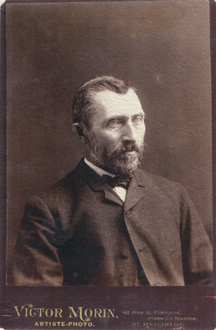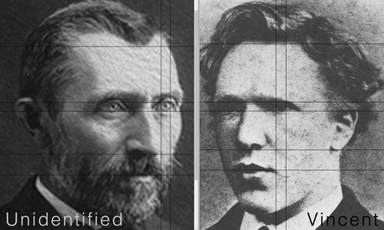Is This A Photograph of Vincent Van Gogh?
by Joelle Steele
 In August of 2006, I came across an online article by Alex Santoso, in which the author tells the story of how a photographer named Victor Morin took photographs of Brussels clergymen circa 1886, one of which looks like some of the self-portraits of Vincent Van Gogh. Santoso stated that when "overlays" – which I don't ever use in authenticating faces – were made of the photograph and some of Van Gogh's self-portraits, there was a resemblance. According to Santoso, the photograph, a 4-1/2" x 6-1/2" cabinet card (left), was "authenticated as being taken between the years of 1885 and 1890." He is probably referring to the authentication made by Albert Harper, the executive director of the Henry C. Lee Institute of Forensic Science at the University of New Haven in Connecticut. The photo was purchased in an antique store in Massachusetts in the early 1990s by a man named Tom Stanford who thought it looked like Vincent Van Gogh.
In August of 2006, I came across an online article by Alex Santoso, in which the author tells the story of how a photographer named Victor Morin took photographs of Brussels clergymen circa 1886, one of which looks like some of the self-portraits of Vincent Van Gogh. Santoso stated that when "overlays" – which I don't ever use in authenticating faces – were made of the photograph and some of Van Gogh's self-portraits, there was a resemblance. According to Santoso, the photograph, a 4-1/2" x 6-1/2" cabinet card (left), was "authenticated as being taken between the years of 1885 and 1890." He is probably referring to the authentication made by Albert Harper, the executive director of the Henry C. Lee Institute of Forensic Science at the University of New Haven in Connecticut. The photo was purchased in an antique store in Massachusetts in the early 1990s by a man named Tom Stanford who thought it looked like Vincent Van Gogh.
 So why do I question the identity of the man in this photograph? Look at the photo comparison below. The irises of the eys have been sized to be the same. When this is done and faces are a match, everything else should line up perfectly. But they don't.
So why do I question the identity of the man in this photograph? Look at the photo comparison below. The irises of the eys have been sized to be the same. When this is done and faces are a match, everything else should line up perfectly. But they don't.
The proportions of the face do not match. That alone is sufficient to rule out a match, because the proportions are based on bone structure, and bones don't lie! The nose is longer and shaped differently. The ears are not a match in size, placement on the head, or ear patterning. The philtrum (the space between the base of the nose and tips of the upper lips is longer in the unidentified man's face. The lower lip in the unidentified man is not full the way Vincent's is. In the unidentified man his browline is higher, making his eyes more wide-opened than Vincent's. The remaining hairline of the unidentified man is lower than Vincent's.
Now, if that's not enough, you can look at the provenance, which I disregard in all cases since it is irrelevant when measuring and comparing faces. A face either is or is not a match regardeless of provenance. But here are the discrepancies in the provenance:
 First, while the timing could be correct since Van Gogh was in Belgium circa November/December of 1885 through at least January of 1886 after which he is in Paris and then in the south of France, Morin's information on the cabinet card itself clearly states that he is located at 42 Rue St.-Francois, Place du Marche, St. Hyacinthe. This is not in Belgium. It's not even in Europe. It's in Canada. A photo historian, Joseph Buberger, somehow matched Morin to an old studio in Brussels, but while I cannot pretend that such a place does not exist, I couldn't find any history of a photographer named Victor Morin in Belgium. I did find a street named St. Francois in Paris and also one in the Brussels municipality of Saint-Josse-ten-Noode. However, the only St. Hyacinthe is in Quebec, Canada. One Internet article actually posted a page from a 19th century business directory which shows Morin & Messier as photographers at the St. Hyacinthe address. If Morin had a studio in Belgium or Paris, it seems unlikely that he would use a Canadian address on his cabinet cards, and if he was ever in Europe, I could find no record of it.
First, while the timing could be correct since Van Gogh was in Belgium circa November/December of 1885 through at least January of 1886 after which he is in Paris and then in the south of France, Morin's information on the cabinet card itself clearly states that he is located at 42 Rue St.-Francois, Place du Marche, St. Hyacinthe. This is not in Belgium. It's not even in Europe. It's in Canada. A photo historian, Joseph Buberger, somehow matched Morin to an old studio in Brussels, but while I cannot pretend that such a place does not exist, I couldn't find any history of a photographer named Victor Morin in Belgium. I did find a street named St. Francois in Paris and also one in the Brussels municipality of Saint-Josse-ten-Noode. However, the only St. Hyacinthe is in Quebec, Canada. One Internet article actually posted a page from a 19th century business directory which shows Morin & Messier as photographers at the St. Hyacinthe address. If Morin had a studio in Belgium or Paris, it seems unlikely that he would use a Canadian address on his cabinet cards, and if he was ever in Europe, I could find no record of it.
Second, while the photograph does resemble Van Gogh as depicted in his self-portraits, I know from more than 35 years of examining 180,000 photographs of people and then analyzing and comparing more than 25,000 of those faces to authenticate their identities, that resemblance doesn't count for much when authenticating identities. I have personally found hundreds of photographs of people who look alike but are not related. Measurements of the faces prove they are not the same people. François Brunelle of Montréal, Canada photographs people from all over the world who just happen to look alike, but again, their measurements are not a match. The only way to accurately authenticate the identity of the face in this photograph as that of Vincent Van Gogh is to measure the faces in the photo and in the self-portraits, convert the measurements to proportions, and then compare the proportions. But, when comparing a face in art to one in a photograph, this can be a very messy business, and in this case, we're dealing with an artist who has depicted himself in a wide variety of mental and physical states. An accurate comparison with his art is virtually impossible.
Third, the face in the photograph purported to have been taken in Belgium circa 1886, looks far too old to be Vincent Van Gogh, who would have been only 33 years old at that time. Even if we were to allow for him having an unhealthy life, physically and mentally, the man in the photograph appears to be at least 50, possibly 60 years old. In examining an enlarged and very high resolution version of the photograph, I could very clearly see that the man has gray hairs throughout his beard and parts of his hair, crow's feet at the corners of his eyes, and deep lines in his cheeks. The ears, brow line, eye orbits, nose shape, and facial proportions are not matches for the 1871 photograph (left) of Vincent taken when he was working for Goupil et Cie in The Hague, Netherlands, at 18-19 years of age, face fully adult.
 There is an 1886 portrait of Vincent (left) painted by an Australian artist, John Peter Russell, hanging in the Van Gogh Museum in Amsterdam, and this particular portrait appears on the surface to be a rather striking match for the 1885-86 Morin photograph. Russell was living in Paris when he became friends with Vincent, who lived there from approximately March 1886 to February 1888. The two left Paris the same year, and corresponded with each other until Vincent's death in 1890. But Russell's portrait is not an exact match for the 1885-86 photograph. However, it's a pretty good match for the 1871 photograph, even down to the ear pattern in the rather rumpled ear of the portrait. I think it's possible that Russell's portrait provides us with what may be the best depiction of Vincent Van Gogh as an adult.
There is an 1886 portrait of Vincent (left) painted by an Australian artist, John Peter Russell, hanging in the Van Gogh Museum in Amsterdam, and this particular portrait appears on the surface to be a rather striking match for the 1885-86 Morin photograph. Russell was living in Paris when he became friends with Vincent, who lived there from approximately March 1886 to February 1888. The two left Paris the same year, and corresponded with each other until Vincent's death in 1890. But Russell's portrait is not an exact match for the 1885-86 photograph. However, it's a pretty good match for the 1871 photograph, even down to the ear pattern in the rather rumpled ear of the portrait. I think it's possible that Russell's portrait provides us with what may be the best depiction of Vincent Van Gogh as an adult.
Four, the most damning evidence is that the experts at the Van Gogh Museum in Amsterdam do not believe that this is a photograph of Vincent Van Gogh. If anyone, any entity, was going to really want to authenticate this photograph and acquire it at any price, it would be the Van Gogh Museum. If they don't think it's Vincent, I am certainly willing to bow to their expertise with his art, his life, and certainly with his face.
So, is that Vincent in the Victor Morin photograph? No, unfortunately, it isn't.

